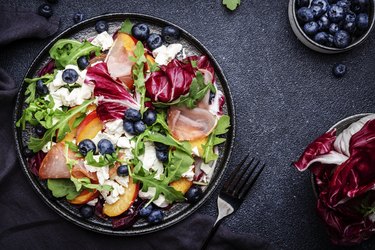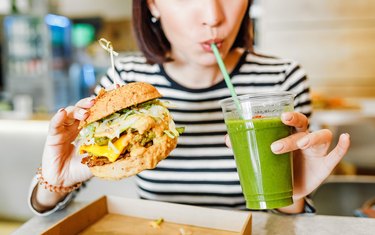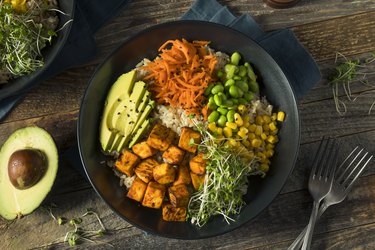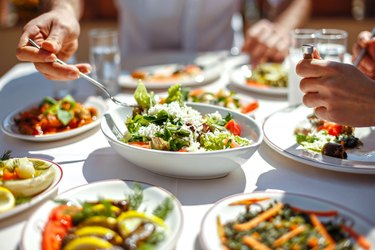
When you think about eating healthier, do visions of boring lettuce dance through your mind? Salads are notoriously dubbed "rabbit food" and considered a mainstay of dieters, but they can be downright crave-worthy with the right mix of ingredients.
And if you plan it right, eating salads frequently can also improve your health.
Video of the Day
Video of the Day
4 Benefits of Eating Salad Daily
Salads can be your best friend or your worst enemy, depending on how you toss 'em. Lean on ingredients that benefit your health, like vegetables, fruits, lean proteins, healthy fats and dairy. Keep those that detract from it, like fried chicken, creamy dressing or bacon, to smaller portions.
Some of the benefits that accompany eating salad on a daily basis are:
1. It Keeps You Regular, and Improves Overall Gut Health
When you eat a salad, you are most likely increasing the amount of vegetables in your meal. Most adults should aim to eat 2.5 cups of vegetables each day, per the The Dietary Guidelines for Americans 2020-2025. That daily goal is easy to reach (or exceed) when you eat a salad.
Having more veggies means that you'll be getting more fiber in your diet. The Academy of Nutrition and Dietetics recommends eating 14 grams of fiber for every 1,000 calories in your diet. That comes out to about 25 to 38 grams of fiber per day. Fiber only comes from plant foods, so adding more vegetables to your day means adding more fiber.
And that additional fiber means better gut health in multiple ways.
First of all, both soluble and insoluble fiber help you poop. Soluble fiber, which forms a gel in the digestive tract, helps soften stool, per Johns Hopkins Medicine. Meanwhile, insoluble fiber bumps up the bulk of stool, which makes it easier to pass, according to the Mayo Clinic. Eating different kinds of vegetables in your salad delivers the most benefit, as you'll get both types of fiber.
Fiber is also fermented in the gut by bacteria, which helps to produce postbiotics — these can help reduce allergy symptoms and relieve constipation and diarrhea, according to the Cleveland Clinic.
2. It Benefits Your Heart Health
A diet high in fruits and vegetables — like yours when you start eating a daily salad — has been shown in numerous studies to support heart health, according to the Harvard T. H. Chan School of Public Health.
A June 2017 meta-analysis and systematic review in the International Journal of Epidemiology found you can reduce your risk of developing cardiovascular disease with a daily intake of 800 grams of fruits and vegetables. Because you probably aren't weighing your daily apple, that's anywhere between 5 to 10 servings of fruits and veggies each day. (Take a look at the serving size of several vegetables compared to everyday objects, like a dollar bill or fork.)
While all fruits and vegetables are beneficial for your heart, leafy greens — typically the base of a hearty salad — have been specifically found to lower the risk of heart disease and stroke, per the Harvard T.H. Chan School of Public Health.
3. It Supports Your Weight-Loss Goals
Salads can be made with a variety of vegetables and fruits, which all contain good amounts of fiber. In an October 2019 study in the Journal of Nutrition, fiber intake was found to be one of the best predictors of weight loss and sticking to a healthy diet.
Dietary fiber isn't digested by the body, so you get to absorb all of the nutrients and gain all the gut benefits that come with high-fiber foods, but the fiber passes through — it's a win-win for your health.
Smart choices in your salad-making routine will keep you from making regular runs to the pantry for snacks. If you find yourself reaching for more food after you eat a salad, take a look at what's in your bowl. Fill your salad with satiating ingredients to help keep you full — always include a protein, add whole grains for more fiber and fill up on vegetables.
Vegetables you might typically find in a salad, such as greens, tomatoes and cucumbers, are packed with water and are low in calories, so it's not only the protein and fiber that can help keep you full, it's also the extra water you're getting.
4. Salad Is Good for Your Skin
The vitamins, minerals and water from your daily salad will help keep your skin healthy.
Many of the nutrients you get from a healthy salad are essential in helping with collagen formation and protection from ultraviolet (UV) rays, according to a January 2021 research review on nutrition for skin health in Nutrients.
Nutrients for Healthy Skin
Skin Health Benefit | Salad Ingredients | |
|---|---|---|
Vitamin C | Helps with collagen formation. Helps protect against UV rays. | Tomatoes, bell peppers, broccoli, strawberries, cabbage |
Vitamin A | Helps build and protect collagen. Helps protect against UV rays. | Carrots, egg yolks, sweet potatoes, kale, spinach |
Vitamin E | Helps with collagen formation. Helps protect against skin inflammation from sunburn. | Sunflower seeds, almonds, spinach, peanuts, mango |
Selenium | Helps reduce skin inflammation. Helps protect the skin from UV stress. | Chicken, eggs, broccoli, cabbage, onions, mushrooms, Brazil nuts |
Zinc | Prevents UV damage. Helps with skin repair. | Pumpkin seeds, lentils, shrimp, cheddar cheese, eggs |
Copper | Protects skin structure. Helps make melanin. | Potatoes, mushrooms, cashews, sunflower seeds, chickpeas |
Silicon | Helps make collagen. Improves skin surface. | Radishes, raisins, carrots, beets, potatoes, onions |
How to Build the Perfect Salad
There's more than one way to build the perfect salad. If you're going to eat a salad every day, variety will be important, but having a salad-building roadmap will be your ticket to success. Some tips to keep in mind:
- Pile on the greens. Your chosen leafy greens do more than just lay a foundation for your salad. They are low in calories and full of nutrients, such as A, C, E and K.
- Vary what you put on the plate. Choosing a variety of vegetables and fruits will add more nutrition, color and layers of flavor.
- Include protein. If a salad is the main course for your meal, protein is a must to keep you fueled and not running for a snack shortly after your meal. For meat eaters, chicken, tuna, salmon and eggs taste great in salads. Plant-based proteins, like lentils, beans, edamame and tofu are also great options for vegans and omnivores alike.
- Add healthy fats. Choose a drizzle of olive oil with balsamic vinegar as a staple dressing. If you want a creamy dressing, choose one that's yogurt or avocado-based. A handful of olives, sunflower seeds, almonds or walnuts are also sources of healthy fats.
There are many layers to a salad, so you want to make sure you are optimizing nutrition and making a salad that will fill you up. When building your layers, choose a variety of ingredients from the following table to get in all of your macronutrients — carbohydrates, proteins and fats — for a complete and healthy meal.
How to Build the Perfect Main Dish Salad
Ingredient Suggestions | Amount | |
|---|---|---|
Greens | Iceberg lettuce, romaine lettuce, spinach, kale, watercress, Swiss chard | 2 cups |
Veggies | Bell peppers, tomatoes, cucumbers, roasted potatoes/sweet potatoes, peas, corn, onions | 1 to 2 cups |
Fruit | Strawberries, peaches, apples, blueberries, raisins, dried cranberries | Fresh fruit: 1/2 cup Dried fruit: 1/4 cup |
Grains | Brown rice, wild rice, farro, quinoa | 1/2 cup cooked |
Dairy | Hard cheese: Parmesan, asiago Semi-hard cheese: cheddar, Swiss Soft/crumbly: gorgonzola, feta | Hard: 1/3 cup Semi-hard: 1/4 cup Soft/crumbly: 1/4 cup |
Proteins | Grilled chicken, tofu, eggs, salmon, tuna, lentils, chickpeas, edamame | 3 to 4 ounces |
Nuts/Seeds | Sunflower seeds, almonds, cashews, peanuts | 1/4 cup |
Dressing | Vinaigrette, salsa, hummus, tzatziki | 2 tablespoons to 1/4 cup |
Here is an example of a salad recipe that'll delight your taste buds:
- 2 cups butter lettuce
- 1/2 cup roasted sweet potatoes
- 1/4 cup red bell peppers
- 1/4 cup red onion
- 1/4 cup dried cranberries
- 3 ounces grilled chicken breast
- 1/4 cup chopped walnuts
- 2 tablespoons balsamic vinaigrette
- Dietary Guidelines for Americans 2020-2025
- The Journal of Nutrition: "Fiber Intake Predicts Weight Loss and Dietary Adherence in Adults Consuming Calorie-Restricted Diets: The POUNDS Lost (Preventing Overweight Using Novel Dietary Strategies) Study"
- Nutrients: "Bioactive Compounds for Skin Health: A Review"
- International Journal of Epidemiology: "Fruit and Vegetable Intake and the Risk of Cardiovascular Disease, Total Cancer and All-Cause Mortality—A Systematic Review and Dose-Response Meta-Analysis of Prospective Studies"
- Academy of Nutrition and Dietetics: "Fiber"
- American Heart Association: "Suggested Servings from Each Food Group"
- National Institutes of Health Office of Dietary Supplements: "Dietary Supplement Fact Sheets"
- Johns Hopkins Medicine: "Foods for Constipation"
- Mayo Clinic: "Dietary fiber: essential for a healthy diet"
- Harvard T.H. Chan School of Public Health: "The Microbiome"
- Cleveland Clinic: "What Are Postbiotics?"
- Harvard T.H. Chan School of Public Health: "Vegetables and Fruits"
Was this article helpful?
150 Characters Max
0/150
Thank you for sharing!
Thank you for your feedback!








